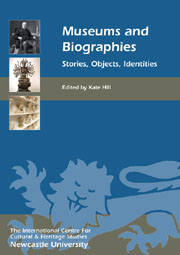Book contents
- Frontmatter
- Contents
- List of Illustrations
- Introduction: Museums and Biographies – Telling Stories about People, Things and Relationships
- INDIVIDUAL BIOGRAPHY AND MUSEUM HISTORY
- PROBLEMATISING INDIVIDUALS' BIOGRAPHIES
- 4 ‘His Best Successor’: Lady Eastlake and the National Gallery
- 5 Women, Museums and the Problem of Biography
- 6 A Curatocracy: Who and What is a V&A Curator?
- INSTITUTIONAL BIOGRAPHIES
- OBJECT BIOGRAPHIES
- MUSEUMS AS BIOGRAPHY
- MUSEUMS AS AUTOBIOGRAPHY
- Endpiece: The Homunculus and the Pantograph, or Narcissus at the Met
- List of Contributors
- Index
4 - ‘His Best Successor’: Lady Eastlake and the National Gallery
from PROBLEMATISING INDIVIDUALS' BIOGRAPHIES
Published online by Cambridge University Press: 05 February 2013
- Frontmatter
- Contents
- List of Illustrations
- Introduction: Museums and Biographies – Telling Stories about People, Things and Relationships
- INDIVIDUAL BIOGRAPHY AND MUSEUM HISTORY
- PROBLEMATISING INDIVIDUALS' BIOGRAPHIES
- 4 ‘His Best Successor’: Lady Eastlake and the National Gallery
- 5 Women, Museums and the Problem of Biography
- 6 A Curatocracy: Who and What is a V&A Curator?
- INSTITUTIONAL BIOGRAPHIES
- OBJECT BIOGRAPHIES
- MUSEUMS AS BIOGRAPHY
- MUSEUMS AS AUTOBIOGRAPHY
- Endpiece: The Homunculus and the Pantograph, or Narcissus at the Met
- List of Contributors
- Index
Summary
In 1875, Lady Eastlake, the widow of the first Director of the National Gallery, confided to a cousin that she believed herself to have been the best person to have succeeded her husband in the management of the Gallery:
I had such an exceptional education in connoisseurship at my beloved One's side – & there is scarcely a creature with whom I can share it. I feel that I shd have been his best successor in the direction of the Nat: Gallery. Boxall was unimpugnable, but hated the employmt, the present man is totally unfit for it, & has introduced most inferior things. Without vanity I know I shd have been the right person, tho' the world wd be astonished at such an idea.
(Sheldon 2009a, 407)Those connected to the National Gallery in the years following Sir Charles Eastlake's death would not perhaps be astonished by the idea. The widowed Lady Eastlake, having spent ten years as the loyal and companionable helpmeet of the first Director, became a relentless campaigner in the preservation of her husband's legacy. ‘His best successor’ continued to offer intercessory – and not always welcome – advice to Eastlake's official successors, including what to purchase and whom to appoint, and earning herself a reputation for interference. Institutional biographies are often enriched by their association with colourful characters and Lady Eastlake has been a persistent and vivid presence in histories of the National Gallery.
- Type
- Chapter
- Information
- Museums and BiographiesStories, Objects, Identities, pp. 61 - 74Publisher: Boydell & BrewerPrint publication year: 2012



